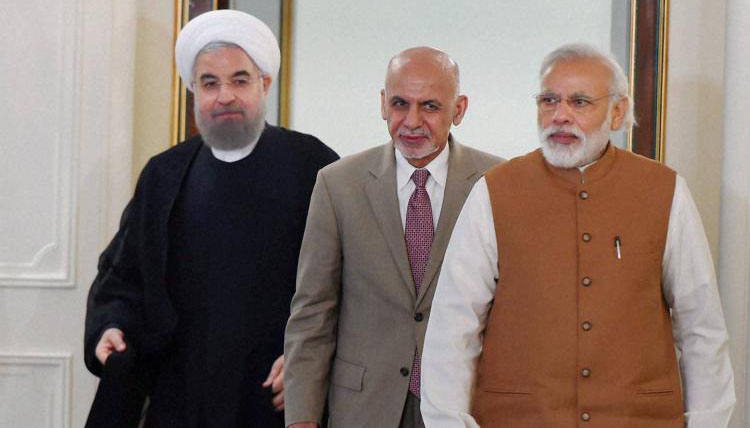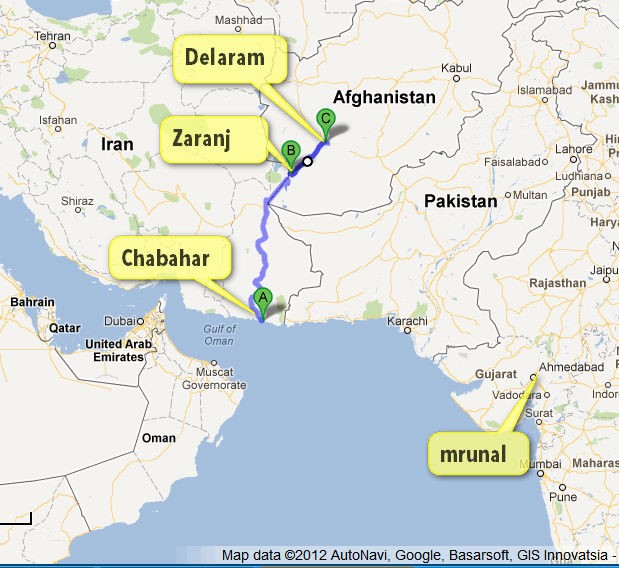
Chabahar Agreement and Afghan-Indian Relations
On May 23, Indian Prime Minister Narendra Modi, Iranian President Hassan Rouhani and the Afghan President Ashraf Ghani, signed a three-way transit agreement on Iran’s southern port of Chabahar. India will invest about $500 million for developing the port and adjoining economic zone. It will provide India an access to the land-locked countries of central Asia. But, it will benefit the region, at the same time.
Prime Minister Modi said in a statement, “We want to link to the world, but connectivity among ourselves is also a priority. The bilateral agreement to develop the Chabahar port and related infrastructure, and availability of about $500m from India for this purpose, is an important milestone. This major effort would boost economic growth in the region.”
India will invest $85 million to build a container terminal & a multi-purpose cargo terminal.Indian public sector and private companies together will make an investment worth $22 billion in the Chabahar free trade zone area covering chemicals, petrochem, steel and fertilizer sectors. Indian railways likely to invest in the region with Iran planning to develop Chabahar as a petroleum hub.
Chabahar port will be economically beneficial for Iran as well. With the lifting of US inspired N-sanction were lifted, Iran is seeking to strengthen and speed up economic ties and activities. President Hassan Rouhani said much at his press conference. “With our joint investments in Chabahar, we can connect India through a reliable route to Afghanistan and countries in Central Asia… The agreement today is not only an economic document: It’s also a political and a regional one.”
This is a welcome development from Afghanistan’s perspective. Because Chabahar will provided Kabul sea-land access by the end of this year. A joint venture of Kandla Port Trust (KPT) and Jawaharlal Nehru Port Trust (JNPT) started work on Chabahar last year itself. When completed, the port will provide to Afghanistan a better access to Indian market besides allowing it trade and robust business activities through its land mass.
But most importantly it will pave the way for further economic cooperation with India and Iran. As President Ghani said in a statement, “Our will starts from Chabahar today, but its end will be an all-out comprehensive development and economic-cultural cooperation.”
India seeks to expand its economic presence in Afghanistan in the post withdrawal era. In particular, it wants to improve transport connectivity and economic collaboration with countries in Central and South Asia. More such projects are likely to come up, which includes setting up Iron ore mines, a 6 MTPA steel plant (by Steel Authority of India Limited, SAIL), an 800 MW power plant, Hydro-electric power projects, transmission lines, and roads.
 Afghanistan is developing its very own Garland Highway, setting up road access to four major cities — Herat, Kandahar, Kabul and Mazar-e-Sharif. Chabahar port can be reached using the existing Iranian road network up to Zaranj in Afghanistan (about 883 kms from the port), and the Zaranj-Delaram road, constructed by India in 2009.
Afghanistan is developing its very own Garland Highway, setting up road access to four major cities — Herat, Kandahar, Kabul and Mazar-e-Sharif. Chabahar port can be reached using the existing Iranian road network up to Zaranj in Afghanistan (about 883 kms from the port), and the Zaranj-Delaram road, constructed by India in 2009.
India’s extensive developmental assistance programme, which equals around $2 billion, is an indicator of its abiding commitment to peace, tranquillity and prosperity in Afghanistan during this critical juncture of security and governance transition. This makes India one of the leading donor nations to Afghanistan, and by far the largest among the regional countries.
India seems to believe that development of Afghanistan requires reliable and lasting investment that can help the country to exploit its natural resource properly. Therefore, India stands at the forefront of the promotion of investments; a consortium of public and private Indian companies has been selected to make one of the largest investments in the country’s mining sector, in the Hajigak iron ore reserves.
India realizes the fact that there can be stability in Afghanistan only if all the major actors and countries have a stake in its stability, development and growth. Realizing this India has been increasing efforts to attract regional and trans-regional investment into Afghanistan that provides a reliable alternative to the dominant narrative of extremism and offers job opportunities to its population, by initiating events like the Delhi Investment Summit on Afghanistan in June 2012.
India helped initiate a dialogue on Afghanistan through different platforms like the Afghanistan-India-US trilateral and the Afghanistan-India-Iran trilateral platforms that seek to bring together international partners with disparate worldviews to follow the common goal of securing peace and prosperity in Afghanistan. India also expressed its assistance to international cooperation on Afghanistan at the UN and at various international conferences that are focused on the future of Afghanistan, including the seminal Tokyo Developmental Conference in July 2012.
In the post withdrawal Afghanistan, as there are security, financial and political challenges, Afghanistan would require developing strong economic ties with the regional countries and as India plays a dominant role in the region, it can support Afghanistan in achieving such an objective. Moreover, in the times of challenges and troubles Afghan people and government would require true support and assistance; therefore, India’s support for Afghanistan will of immense importance and the people of Afghanistan also realize this fact and they wish that India should keep its assistance continue until it is able to stand on its own.
– with thanks to Outlook Afghanistan
-
CHINA DIGEST
-
 ChinaChina Digest
China’s PMI falls for 3rd month highlighting challenges world’s second biggest economy faces
ChinaChina Digest
China’s PMI falls for 3rd month highlighting challenges world’s second biggest economy faces
-
 ChinaChina Digest
Xi urges Chinese envoys to create ‘diplomatic iron army’
ChinaChina Digest
Xi urges Chinese envoys to create ‘diplomatic iron army’
-
 ChinaChina Digest
What China’s new defense minister tells us about Xi’s military purge
ChinaChina Digest
What China’s new defense minister tells us about Xi’s military purge
-
 ChinaChina Digest
China removes nine PLA generals from top legislature in sign of wider purge
ChinaChina Digest
China removes nine PLA generals from top legislature in sign of wider purge
-
-
SOUTH ASIAN DIGEST
-
 South Asian Digest
Kataragama Kapuwa’s arrest sparks debate of divine offerings in Sri Lanka
South Asian Digest
Kataragama Kapuwa’s arrest sparks debate of divine offerings in Sri Lanka
-
 South Asian Digest
Nepal: Prime Minister Dahal reassures chief ministers on police adjustment, civil service law
South Asian Digest
Nepal: Prime Minister Dahal reassures chief ministers on police adjustment, civil service law
-
 South Asian Digest
Akhund’s visit to Islamabad may ease tensions on TTP issue
South Asian Digest
Akhund’s visit to Islamabad may ease tensions on TTP issue
-
 South Asian Digest
Pakistan: PTI top tier jolted by rejections ahead of polls
South Asian Digest
Pakistan: PTI top tier jolted by rejections ahead of polls
-






Comments